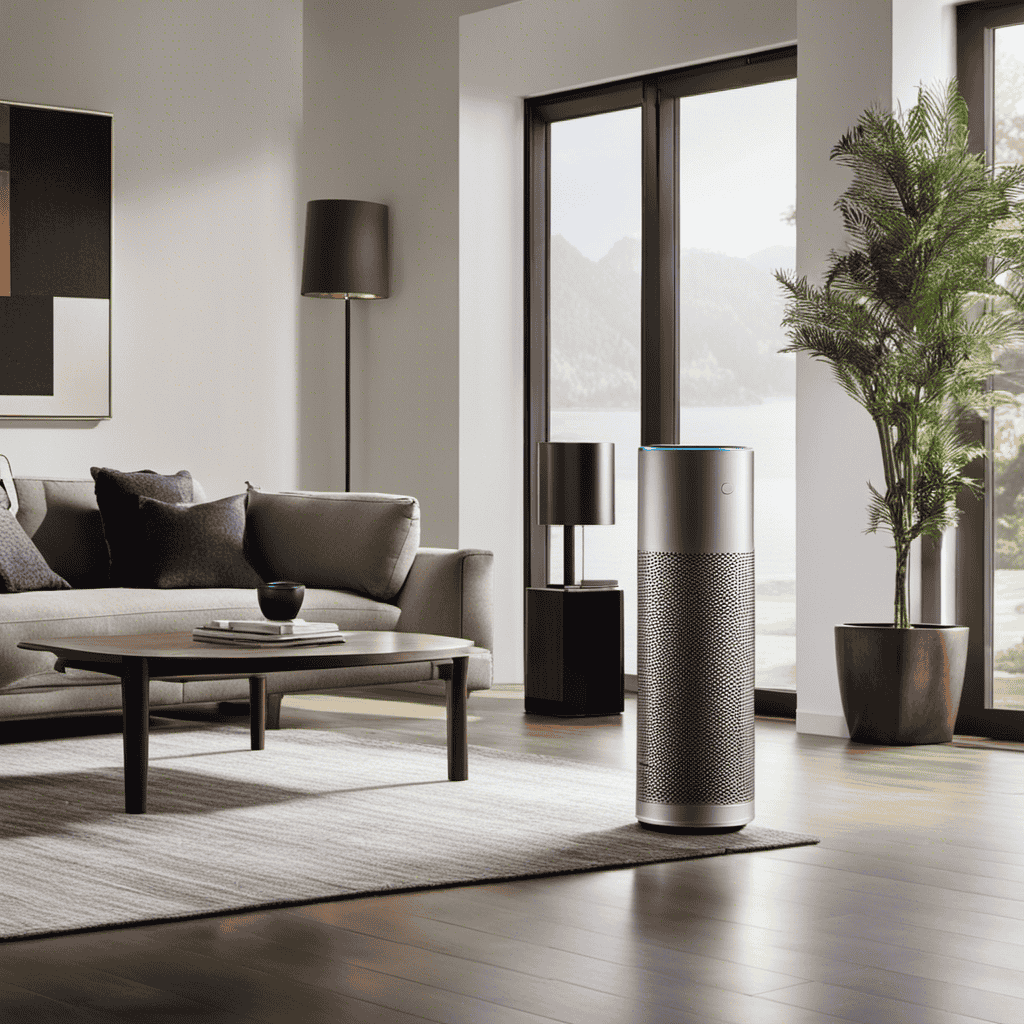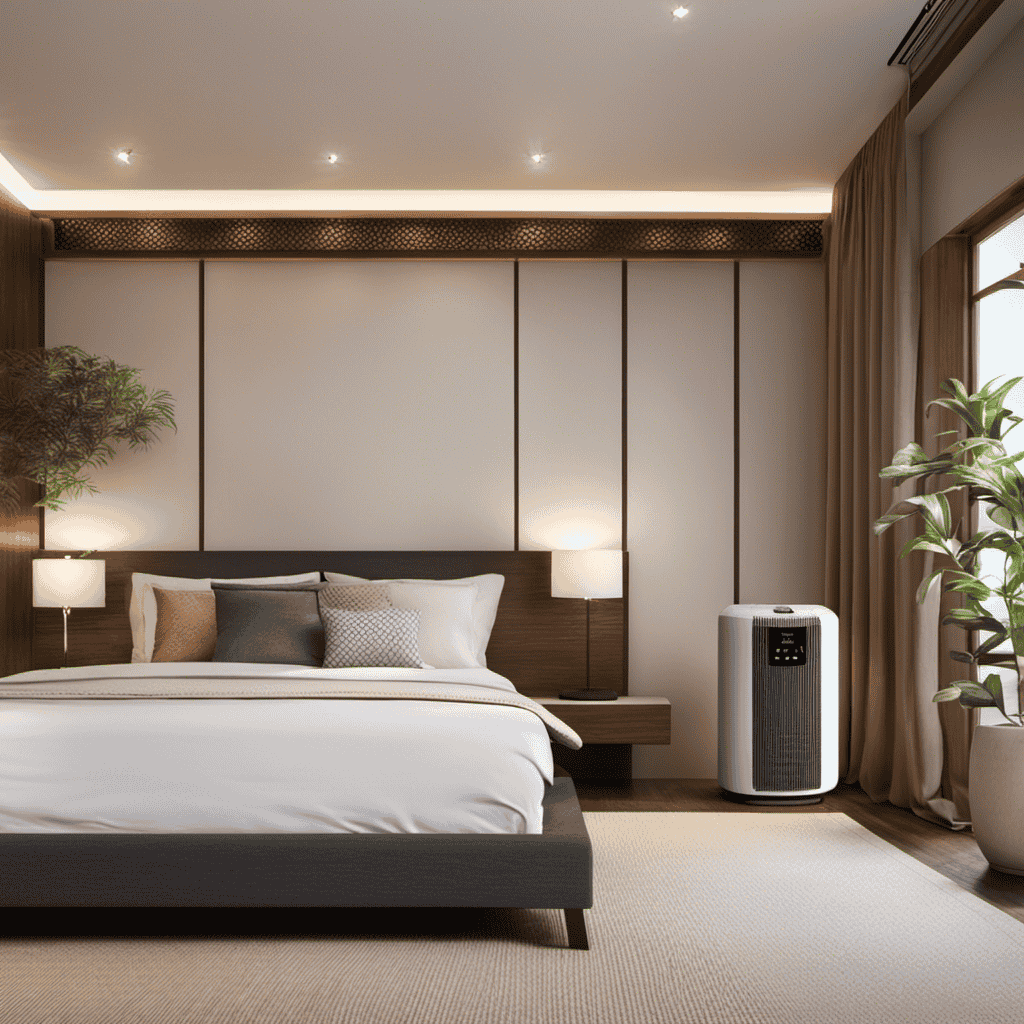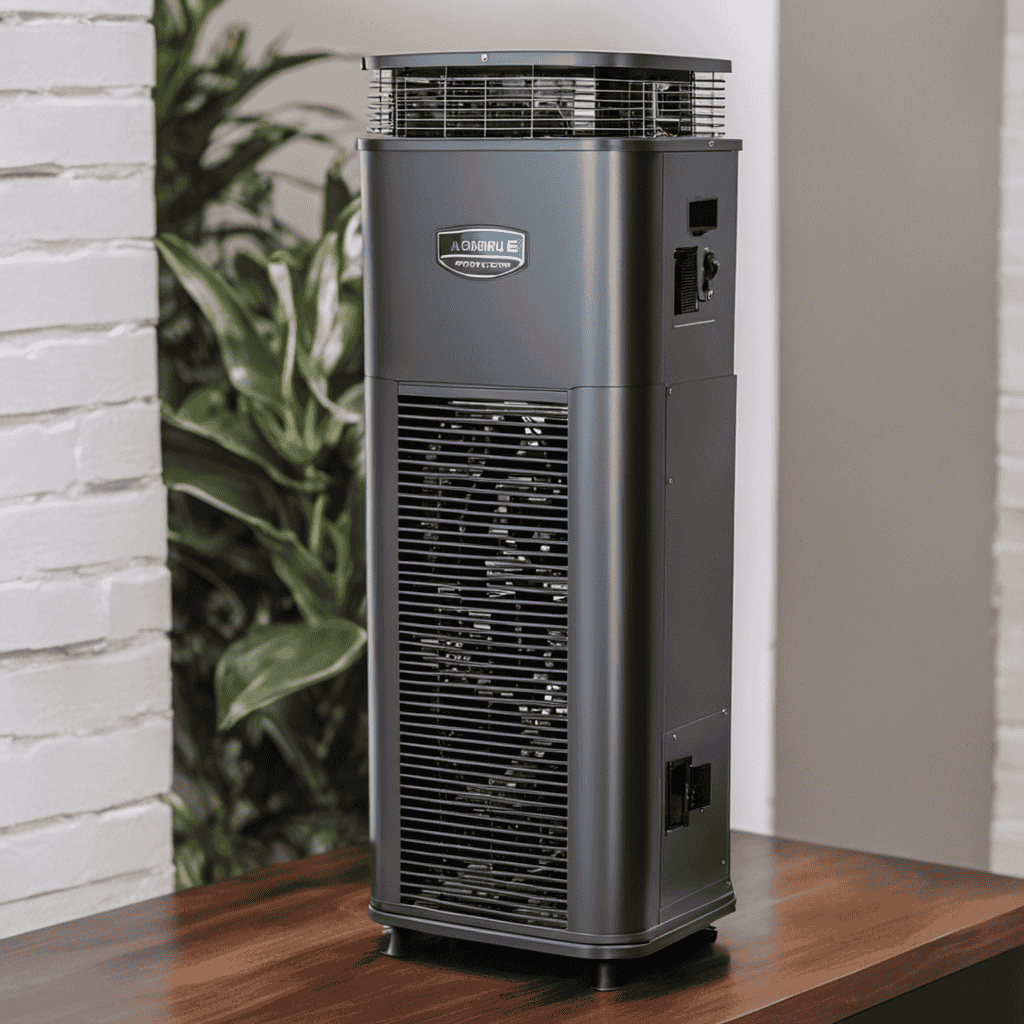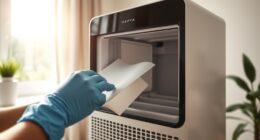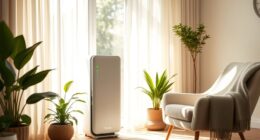Were you aware that the air inside can be as much as five times more contaminated than the air outside? This surprising fact underlines the critical need to keep the air in our homes clean and conducive to good health.
In this article, I will explore when to use an air purifier to improve the quality of the air we breathe. From allergies and pet dander to odors and productivity, I will provide you with valuable information on how air purifiers can enhance your environment and promote overall well-being.
Key Takeaways
- Air purifiers can improve sleep and reduce respiratory symptoms.
- Air purifiers remove harmful pollutants like dust, pet dander, pollen, and mold spores.
- Air purifiers alleviate symptoms of allergies, asthma, and other respiratory conditions.
- Air purifiers effectively reduce the concentration of allergens in the air.
Benefits of Using an Air Purifier
You’ll love the benefits of using an air purifier in your home.
Air purifiers have proven to be effective in improving sleep and reducing respiratory symptoms. Studies have shown that air purifiers can help create a healthier indoor environment by removing harmful pollutants such as dust, pet dander, pollen, and mold spores.
By reducing these irritants, air purifiers can alleviate symptoms of allergies, asthma, and other respiratory conditions. Additionally, air purifiers can create a cleaner and fresher atmosphere, which can promote better sleep. When the air is free from pollutants, it allows for easier breathing and can help prevent nighttime congestion and snoring.
Now that we understand the benefits of air purifiers for improving sleep and reducing respiratory symptoms, let’s explore how they can work together to combat allergies.
Allergies and Air Purifiers: How They Work Together
If you suffer from allergies, it’s important to understand how air purifiers can help alleviate symptoms. Air purifiers are designed to remove airborne allergens such as pollen, dust mites, and pet dander from indoor air, improving indoor air quality and reducing allergy triggers. Here is a table that shows the impact of air purifiers on indoor air quality:
| Air Pollutant | Before Air Purifier | After Air Purifier |
|---|---|---|
| Pollen | High levels | Low levels |
| Dust Mites | High levels | Low levels |
| Pet Dander | High levels | Low levels |
As you can see, air purifiers effectively reduce the concentration of allergens in the air, helping to alleviate symptoms of seasonal allergies. By removing these allergens, air purifiers create a healthier environment for individuals with allergies. In the next section, we will discuss the signs that indicate you may need an air purifier to further improve your indoor air quality.
Signs That You Need an Air Purifier
As an air quality expert, I can confidently say that using an air purifier can provide numerous health benefits.
These devices are designed to remove common air pollutants such as dust, pollen, pet dander, and mold spores from the air we breathe.
Health Benefits of Purifier
Using an air purifier can help improve your health by removing airborne allergens and pollutants from the air you breathe. The health benefits of using an air purifier are numerous and significant.
Air purification techniques used by these devices, such as HEPA filtration and activated carbon filters, effectively capture and eliminate harmful particles like dust, pollen, pet dander, mold spores, and volatile organic compounds (VOCs). This leads to a reduction in respiratory issues, such as allergies, asthma, and other respiratory conditions.
Additionally, air purifiers can also help improve sleep quality by removing irritants that can disrupt sleep patterns. Studies have shown that air purifiers can effectively reduce indoor air pollution, leading to improved overall health and well-being.
Common Air Pollutants
To protect your health, be aware of common pollutants that can be found in the air. Indoor air pollution is a significant concern, as we spend a significant amount of time indoors.
Common household toxins contribute to this pollution and can have adverse effects on our health. These toxins include volatile organic compounds (VOCs) emitted by cleaning products, paint, and furniture. Formaldehyde, commonly found in furniture and building materials, is another harmful pollutant.
Particulate matter, such as dust, pet dander, and pollen, can also contaminate indoor air. Additionally, tobacco smoke and radon gas are major contributors to indoor air pollution.
Air Purifiers for Pet Owners: Keeping Your Home Clean
If you have pets, it’s important to consider using an air purifier to help keep your home clean.
Pet dander, which consists of tiny flecks of skin shed by animals, can cause allergies and respiratory issues in humans.
Air purifiers designed for pet dander control can effectively remove pet allergens from the air, creating a healthier living environment for both you and your furry friends.
These purifiers use advanced filtration systems to capture and trap pet dander particles, reducing allergens in the air by up to 99.97%.
The benefits of air purifiers for pet owners are numerous.
They can alleviate allergy symptoms, reduce pet odors, and improve overall air quality in the home.
The Importance of Indoor Air Quality
Maintaining good indoor air quality is crucial for a healthy living environment. Indoor air pollution can have a significant impact on our health, causing respiratory problems, allergies, and even long-term health issues. To combat indoor air pollution and improve the quality of the air we breathe, using an air purifier can be highly beneficial.
Here are three key benefits of using an air purifier:
-
Removes harmful pollutants: Air purifiers are designed to capture and remove pollutants such as dust, pet dander, pollen, and mold spores from the air, reducing the risk of respiratory problems.
-
Reduces odors: Air purifiers with activated carbon filters can effectively eliminate unpleasant odors, leaving your home smelling fresh and clean.
-
Improves overall health: By removing allergens and pollutants from the air, air purifiers can help alleviate symptoms of allergies and asthma, promoting better overall health.
Investing in an air purifier is a wise choice to create a healthier indoor environment and protect yourself from the harmful effects of indoor air pollution.
How to Choose the Right Air Purifier for Your Home
When choosing the right air purifier for your home, consider factors such as room size, filtration technology, and noise levels.
Room size plays a crucial role in determining the effectiveness of an air purifier. A smaller room may require a compact purifier, while a larger space demands a more powerful model.
Filtration technology is another key factor to consider. High-efficiency particulate air (HEPA) filters are highly effective in removing particles as small as 0.3 microns. Look for purifiers with activated carbon filters to eliminate odors and volatile organic compounds (VOCs).
Noise levels should also be taken into account, especially if you plan to use the purifier in your bedroom or office.
Maintenance tips for air purifiers include cleaning or replacing the filters regularly and keeping the unit away from obstructions to ensure optimal performance.
Air Purifiers for Asthma and Respiratory Health
To improve your respiratory health, consider an air purifier specifically designed for asthma and allergies. These air purifiers are equipped with advanced filtration systems that effectively remove allergens, dust, and other airborne particles from the air. Here are three key reasons why air purifiers are beneficial for individuals with asthma and other respiratory conditions:
-
Reduction of Asthma Triggers: Air purifiers can eliminate common triggers such as pollen, pet dander, and mold spores, which can help alleviate asthma symptoms.
-
Improved Indoor Air Quality: Air purifiers effectively remove pollutants and contaminants from the air, enhancing the overall air quality in your home.
-
COPD Management: Air purifiers can also be beneficial for COPD patients by reducing irritants and pollutants that can exacerbate symptoms.
By investing in an air purifier designed for asthma and allergies, you can create a cleaner and healthier environment for your respiratory health.
Now, let’s explore the difference between air purifiers and humidifiers to help you determine which one is right for your needs.
Air Purifiers Vs. Humidifiers: Which One Do You Need
When it comes to improving indoor air quality, choosing between an air purifier and a humidifier can be a tough decision.
Let’s dive into the key points to consider when deciding which one is right for you.
From filtration capabilities to moisture levels, understanding the specific needs of your environment will help you make an informed choice that aligns with your health and comfort goals.
Purifier or Humidifier
Using an air purifier or a humidifier can greatly improve the air quality in your home. Here are three key benefits of humidifiers:
-
Humidifiers add moisture to the air, which can alleviate dry skin, dry throat, and dry eyes. This is especially beneficial during the winter months when indoor heating can cause low humidity levels.
-
Humidifiers can help relieve respiratory issues such as allergies, asthma, and sinus congestion by reducing airborne allergens and keeping the airways moist.
-
Humidifiers can also protect wooden furniture, musical instruments, and houseplants from drying out and cracking.
While purifiers focus on filtering out pollutants like dust, pet dander, and pollen, humidifiers address the moisture levels in the air. Both devices have distinct functions and can complement each other, depending on your specific needs.
Now that you understand the benefits of humidifiers and the differences between purifiers and humidifiers, let’s move on to choosing the right one for your home.
Choosing the Right One
Now that we have discussed the choice between an air purifier and a humidifier, let’s dive into the factors to consider when choosing the right air purifier. When it comes to air purifier maintenance, it is essential to consider the filter replacement and cleaning requirements. Different models have different filter lifespans and cleaning methods, so it’s important to choose one that fits your maintenance preferences and schedule. Additionally, noise level consideration is crucial, especially if you plan to use the air purifier in your bedroom or office. Look for models with noise levels below 50 decibels for a peaceful and undisturbed environment. To help you make an informed decision, here is a comparison table of some popular air purifiers and their key features:
| Air Purifier | Filter Type | Noise Level (dB) |
|---|---|---|
| Model A | HEPA | 40 |
| Model B | Activated Carbon | 45 |
| Model C | Ionic | 50 |
Now that we have explored the factors to consider when choosing an air purifier, let’s move on to the next section about air purifiers specifically designed for smokers and how they can effectively clear the air.
Air Purifiers for Smokers: Clearing the Air
To clear the air of smoke, you should consider using an air purifier specifically designed for smokers. These purifiers are equipped with advanced technology to effectively remove cigarette smoke particles and odors from the air.
Here are three key features of air purifiers for smokers:
-
High-efficiency filters: These purifiers are fitted with HEPA filters that can capture up to 99.97% of airborne particles as small as 0.3 microns, including smoke particles and harmful chemicals.
-
Activated carbon filters: The purifiers contain activated carbon filters that have excellent adsorption properties, effectively trapping and neutralizing smoke odors.
-
Air circulation and purification: Air purifiers for smokers are designed to have a high Clean Air Delivery Rate (CADR), ensuring rapid air circulation and efficient purification to quickly eliminate smoke.
By using an air purifier specifically designed for smokers, you can significantly improve the air quality in your car or indoor space.
Now, let’s move on to discussing air purifiers for dust and pollen allergies.
Air Purifiers for Dust and Pollen Allergies
If you suffer from dust and pollen allergies, consider opting for an air purifier specifically designed to alleviate your symptoms. Air purifiers for seasonal allergies are equipped with filters that can effectively remove allergens from the air, such as pollen, dust mites, pet dander, and mold spores.
These filters are designed to capture even the smallest particles, ensuring cleaner air in your home.
Additionally, air purifiers for sensitive skin can be beneficial for those prone to skin issues triggered by airborne irritants. These purifiers can help remove pollutants and allergens that may cause skin inflammation, itching, or redness.
Air Purifiers for Mold and Mildew Prevention
Investing in an air purifier specifically designed for mold and mildew prevention can help create a healthier indoor environment. Mold and mildew are common problems that can negatively impact air quality, leading to respiratory issues and allergies. Here are three key reasons why using an air purifier for mold prevention and mildew control is beneficial:
-
Removal of airborne mold spores: Air purifiers equipped with HEPA filters can effectively capture tiny mold spores floating in the air, preventing them from spreading and causing health problems.
-
Elimination of musty odors: Air purifiers with activated carbon filters can help remove unpleasant odors associated with mold and mildew, leaving your indoor space smelling fresh and clean.
-
Reduction of moisture: Some air purifiers feature built-in dehumidifiers that can help control humidity levels, creating an environment less conducive to mold and mildew growth.
When to Use an Air Purifier in Your Bedroom
I’ve found that using an air purifier in my bedroom has greatly improved my sleep quality.
With the air purifier running throughout the night, I wake up feeling more rested and refreshed.
Additionally, the air purifier has helped reduce my allergy symptoms. It provides relief from sneezing, congestion, and itchy eyes.
Lastly, the air purifier has been effective in eliminating unpleasant odors. This creates a more pleasant and comfortable sleeping environment.
Sleep Quality Improvement
Using an air purifier can help improve your sleep quality by reducing allergens and pollutants in the air. Here are three ways an air purifier benefits your sleep and enhances air quality:
-
Removes allergens: Air purifiers are designed to capture and remove common allergens such as dust mites, pet dander, pollen, and mold spores. These allergens can trigger allergies and respiratory issues, leading to disturbed sleep. By eliminating them from the air, an air purifier creates a cleaner and healthier sleep environment.
-
Reduces odors: Air purifiers equipped with activated carbon filters can effectively trap and eliminate unpleasant odors. Whether it’s lingering cooking smells, pet odors, or tobacco smoke, an air purifier helps create a more pleasant and odor-free bedroom, promoting better sleep.
-
Filters out pollutants: Indoor air can contain various pollutants like volatile organic compounds (VOCs), chemicals, and airborne particles. An air purifier with a HEPA filter can capture these pollutants, improving the overall air quality and reducing the potential health risks associated with breathing in these harmful substances.
Allergy Symptom Reduction
To reduce allergy symptoms, consider incorporating an air purifier into your sleep environment. Allergens such as dust mites, pollen, and pet dander can trigger allergies and disrupt your sleep.
An air purifier can effectively remove these allergens from the air, improving the overall air quality in your bedroom. Studies have shown that using an air purifier can significantly reduce the levels of airborne allergens, leading to a reduction in allergy symptoms such as sneezing, coughing, and nasal congestion.
Furthermore, air purifiers can also help prevent allergies by capturing and eliminating mold spores, bacteria, and viruses that may be present in the air.
Odor Elimination Assistance
Consider incorporating baking soda into your cleaning routine to eliminate unwanted odors in your home. Odors can linger in various areas, such as the kitchen or caused by pets. To tackle these odors effectively, you might want to use air purifiers specifically designed for kitchens and pets. Here are three reasons why they are beneficial:
-
Advanced Filtration Technology: Air purifiers for kitchens and pets often come equipped with specialized filters that can capture and neutralize odors at a molecular level.
-
Multiple Odor Elimination: These air purifiers are designed to target a wide range of odors, including cooking smells, pet odors, and even strong spices, ensuring a fresher and more pleasant environment.
-
Improved Air Quality: By removing odors, these air purifiers also help improve the overall air quality in your home, reducing the risk of respiratory issues and creating a healthier living space.
By incorporating baking soda and using air purifiers, you can effectively eliminate unwanted odors in your home.
Now, let’s explore how air purifiers can create a safe environment for babies and children.
Air Purifiers for Babies and Children: Creating a Safe Environment
Air purifiers can help create a safe environment for babies and children by reducing airborne allergens and pollutants. When it comes to safe sleep for infants, it is crucial to ensure that the air they breathe is clean and free from harmful particles.
Indoor pollutants such as dust mites, pet dander, mold spores, and volatile organic compounds (VOCs) can trigger allergies and respiratory issues in young children. By using an air purifier specifically designed for nurseries or children’s rooms, parents can effectively remove these harmful particles from the air, promoting better sleep and overall health for their little ones.
Additionally, studies have shown that cleaner air can improve cognitive function in children, enhancing their learning abilities.
Transitioning to the next section, air purifiers for offices and workspaces can also have a positive impact on productivity.
Air Purifiers for Offices and Workspaces: Boosting Productivity
As an office manager, I understand the importance of creating a workspace that promotes productivity and well-being.
One key factor in achieving this is ensuring cleaner air for our employees. Studies have shown that cleaner air not only improves focus and concentration but also leads to healthier employees and increased productivity.
Cleaner Air, Better Focus
Using an air purifier can help you breathe cleaner air and improve your ability to focus. Here are three ways an air purifier can enhance your concentration:
-
Removes allergens and pollutants: Air purifiers are designed to capture and eliminate common allergens and pollutants such as dust, pollen, pet dander, and mold spores. By reducing these irritants, you can breathe in cleaner air, which promotes better respiratory health and reduces the risk of allergies.
-
Reduces odors and chemicals: Air purifiers equipped with activated carbon filters can effectively remove unpleasant odors and harmful chemicals from the air. This can be particularly beneficial in offices or workspaces where strong smells or off-gassing from furniture and equipment can be distracting and affect your ability to concentrate.
-
Enhances air circulation: Air purifiers with built-in fans help circulate the air in a room, promoting better airflow and reducing stagnant air. Improved air circulation can help prevent stuffiness and maintain a fresh and energizing environment, which can contribute to improved focus and productivity.
Healthier Employees, Increased Productivity
Investing in an air purifier can lead to healthier employees and, as a result, increased productivity. Clean air is essential for employee well-being and can have a significant impact on their overall health and performance. By reducing the presence of airborne pollutants, an air purifier creates a healthier work environment, leading to increased employee satisfaction and reduced sick days.
According to studies, indoor air can be up to five times more polluted than outdoor air. This pollution comes from various sources such as dust, pollen, mold spores, and volatile organic compounds (VOCs) emitted by building materials and cleaning products. Breathing in these pollutants can cause respiratory issues, allergies, and other health problems, leading to decreased productivity.
To demonstrate the benefits of investing in an air purifier, here is a table showcasing the potential improvements in employee satisfaction and sick days:
| Without Air Purifier | With Air Purifier | |
|---|---|---|
| Employee Satisfaction | Decreased | Increased |
| Sick Days | Increased | Reduced |
Air Purifiers for Odor Elimination: Freshen Up Your Space
To freshen up your space and eliminate odors, consider using an air purifier. These devices are designed to remove airborne particles and odorous substances, improving the overall air quality in your home or office. When it comes to specific odors like cooking smells or musty basements, air purifiers can be particularly effective.
Here are three reasons why:
-
Cooking smells: Air purifiers equipped with activated carbon filters can efficiently capture and neutralize cooking odors. These filters are specifically designed to trap volatile organic compounds (VOCs) released during cooking, preventing them from lingering in the air and causing unpleasant smells.
-
Musty basements: Basements are prone to musty odors due to high humidity levels and poor ventilation. Air purifiers with HEPA filters can help remove mold spores, mildew, and other allergens that contribute to these odors, improving the overall air quality in the basement.
-
All-around odor elimination: Many air purifiers feature multiple filtration stages, including pre-filters, activated carbon filters, and HEPA filters. This combination effectively captures and eliminates a wide range of odors, ensuring a fresh and odor-free environment.
Investing in an air purifier can help you eliminate unwanted odors and create a more pleasant living or working space.
Frequently Asked Questions
Can Air Purifiers Remove Viruses and Bacteria From the Air?
Yes, air purifiers can effectively filter out viruses and bacteria from the air. They improve indoor air quality by capturing and trapping these harmful particles, reducing the risk of respiratory infections and allergies.
Are Air Purifiers Effective in Reducing Cooking Odors?
Air purifiers are effective in reducing cooking odors. I’ve noticed a significant improvement in the air quality in my home since using one. It helps eliminate the lingering smells and keeps the air fresh.
Do Air Purifiers Help With Reducing the Spread of Airborne Diseases?
Air purifiers can help reduce the spread of airborne diseases by filtering out particles and viruses. However, they are not a substitute for masks in high-risk situations. Additionally, air purifiers can also help reduce allergies by removing allergens from the air.
Can Air Purifiers Eliminate Cigarette Smoke Completely?
Air purifiers can effectively eliminate cigarette smoke, providing cleaner and healthier air. They are also beneficial for allergies, as they can remove allergens like pollen and pet dander, improving indoor air quality.
Are There Any Side Effects of Using an Air Purifier for an Extended Period of Time?
Using an air purifier for an extended period of time may have potential health risks and long-term effects. It is important to consider factors such as the quality of the air purifier and the individual’s specific health conditions.
Conclusion
In conclusion, an air purifier is a must-have device for anyone concerned about their indoor air quality. It can effectively remove allergens, pet dander, and odors, creating a fresh and clean living space.
Whether you suffer from allergies or want to provide a safe environment for your children, an air purifier can greatly benefit you. It’s like having a personal air guardian, quietly working to improve the air you breathe.
So don’t wait any longer, invest in an air purifier and experience the difference it can make for your health and well-being.

